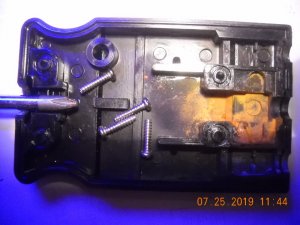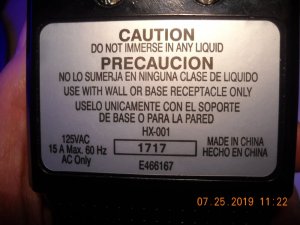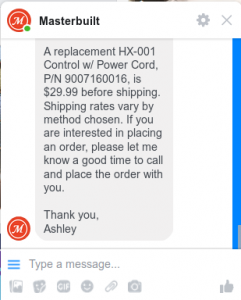I completely forgot about digital and analog smokers. My bad. As far as the heating element problems I had read on here about it and opted for the three year extended warranty.
That connector pictured looks like something from my old Sunbeam electric fry pan had in yester years.
DWDunlap in Richardson, TX
That's exactly what it looks like to me. On an electric skillet or frying pan, the controller has a probe that stabs into the casting of the pan/skillet to sense the temperature. Then there are the two contacts, one on either side of the temperature probe. It looks to me like
Masterbuilt has simply built the smoker to use one of those same electric skillet controller/cord units. That's kind of clever because it takes care of the whole controller/sensor using what is likely a standard part that they can just buy in quantity.
Again, I've never looked at one of these analog
Masterbuilt units, but that's what I'm guessing based on the photos. It's really not a bad way to do things.
You might be able to buy a whole electric skillet with its controller for less than what MB wants for their controller. If so, it's possible that the controller/cord/connector gadget from the skillet would mate properly and work just fine to the smoker! And you wouldn't lose the use of the skillet. You could use the controller for both as long as you don't need to use them both at the same time.
But you'd have to make sure all of the dimensions and specifications are the same. So I really shouldn't even say that. Forget I said it! ;)
Sigmo is RIGHT ON.
Only thing I would comment on is the Caig product.
VERY high quality historied, but spendy.
The BEST available for SOME uses, but in this case., not needed at all.....
#1 - Tightness of the connection, as Sigmo and others have said.
#2- AFTER that, for THIS, I would not spend $20 shipped for Caig, but just put a thin layer of Vaseline on the male Pee Pee..
Don't worry abput too much, the pressure of the female constriction wil wipe off all excess.
Now someone will chime in with "Vaseline is not conductive"
Bottom line, listen to this post and Sigmo.
Lastly, he is being logicaly cautiously prudent in saying toss out the old control, get a new one.
I'm just poor and cheap, and w 30 yr Electrician background. Marc
Yep. That's right.
That "Dielectric Grease" that you find in almost every connector under the hood of a new car is not conductive. And you wouldn't want it to be. It's just there to keep water and corrosive stuff away from the contacts. The contacts still mate, metal-to-metal, where they squeeze the grease out of the way. If it was conductive, it would create short circuits between the pins. Can't have that!
Marc's absoluely right.
And I know about cheap, too! :)
I confess that what I'd likely try for myself is probably a lot like what you advise (except I would use the DeoxIT - but of course, I have a can right next to me as I type this, so that's different).
As for the cost of the DeoxIT:
I agree that it might be a bit over the top to go out and buy a special product just for this one-time use. But the thing is, if you have a can of this around, it'll last a very long time, and you'll think of many uses for it.
A 5 oz can of the D5 lasts even me, doing lots of electronic and electrical repair, installation, and small-scale manufacturing, several years. For most people, they'll only buy one in their lifetime.
I gave a can of the old Cramolin R5 to my dad, and he used it for many years. He's passed away now, but that can is still in the same place in a cupboard above the washing machine, at mom's house, right where Dad kept it. And I use it every so often when I'm working on something electrical for her. I think of Dad every time I use it or any of his tools there.
Anyhow, don't think of DeoxIT as ordinary contact cleaner. Most of that is nothing more than solvent. The solvent stuff can be useful for flushing away grime or getting solder flux off of circuit boards or the like. But the DeoxIt is something you use very sparingly. It's hard to get the newer cans to dispense a small enough amount, actually. The older ones, back when it was called "Cramolin" were easier to control.
Their old ads said something to the effect of "The less you use, the better it works". I always thought the logical conclusion of that would be that to use none at all would be the best! But I guess that's not what they meant.
The advantages of the DeoxIT over Vaseline or other dielectric grease type products is that it dissolves most metal oxides. So it acts as a cleaner. Also the function of filling in the microscopic gaps and improving the conductivity by increasing the effective contact surface area is unique in my experience. And one of the key points here is that we want to lower the contact resistance as much as possible to prevent the kind of overheating we saw in those pictures.
I first heard about it being used for audio equipment where it eliminates the contact diode effect you can get when metal oxides are present in various connectors. It also works great on noisy potentiometers.
But several incidents where I used it really made a believer out of me.
One was a situation where we had a number of self-resetting thermal circuit breakers in a low voltage (12V) system. Small motors which could draw several hundred amperes (briefly) as well as the wiring in the system were protected by these "breakers". There was no real substitute for these gadgets, but they all dropped quite a bit of voltage across them when high current was being drawn. So they limited the peak power to the motors, and this was not acceptable.
Taking these breakers out of the system, and measuring their contact resistances, we found them to typically have up to 200 milliohms. (No doubt the contacts were silver alloy, and thus, tarnish, forming a very hard oxide layer). I took some of the Cramolin Red oil (the equivalent of the "D" type DeoxIT) and mixed up about a 2% solution of Cramolin Red in Freon TF. I then dropped all of the breakers into a jar of this solution and let them sit until the bubbles stopped coming out. Then I'd pull them out, let the solution run back out of them, and they then had a film of the Cramolin Red oil everywhere inside and out.
Then I just rapped each of these breakers on a table top a number of times to make their contacts jiggle inside. That allowed the Cramolin to rub between the contacts, cleaning and treating them. You couldn't open the breakers because they were riveted shut.
The average contact resistance for each one then went down to less than 6 milliohms! Not bad for not even being able to directly get to the contacts to properly clean them!
The system then worked reliably for many years with no further intervention.
Another anecdote was a whole series of Varian gas chromatographs that had an ongoing problem of blowing power fuses that protected the wiring and circuitry for their column oven heating elements. They drew about 15 amps at 120VAC, not unlike our smokers.
You'd find the power fuse blown, but it wouldn't really be blown from overcurrent. Instead, it would be well cooked, and the wires and faston connectors feeding the fuse would also be burned back for several inches from the fuseholder.
So the problem was just bad contact between the fuseholder and the fuse itself, causing overheating. Eventually, the fuse element would melt, but not due to overcurrent.
So you had to replace some wiring, the fuseholder, and the fuse, of course, to get them going. But you knew it'd just fail again before too long. One of the problems in a laboratory seems to always be hydrochloric acid fumes. HCl seems to produce the most insidious fumes of all of the acids for some reason. And it really goes after electrical contacts.
Anyhow, simply treating the new fuseholder and fuse with Cramolin Red (like the new DeoxIT D5) made the things run forever with no further problems.
I used to have to buy it directly from Caig Labs. Then they got into some sort of legal battle with the original manufacturer in Germany and changed the name and the formula and started selling it through various retailers. For a while I could get it from a local electronics store. But
Amazon also has it, and I get free Prime shipping, so that's where I've gotten in most recently.
I see it on
Amazon right now for $14.18 with free shipping for Prime members, or $11.95 + $3.49 shipping from another seller for non-prime. I think Parts Direct and Guitar Warehouse, etc., also sell it now.
Really. If you haven't tried it, I highly recommend it. Shake the can, then try to get just a tiny amount of it to come out. Or squirt a bit of it into the bud of a Q-Tip type swab to apply it. It takes practice (especially with the new cans) to get them to just dribble a small amount out. They want to go off all at once and spray out about 100 times as much as you really want. I've blasted myself in the face with it on a number of occasions trying to get a little bit into a small opening, but having it suddenly spray out a blast and bounce back at me. That can't be good!
A small glass vial (like what we call a VOA vial in the laboratory) is a good thing to spray some into. They have teflon-lined seals, so you have only glass and teflon in contact with the stuff. Then you have a little bit that you can get out with a swab or the like. You can also drop contacts to be treated into the vial, put the lid on, and shake it around to treat them, then fish them out with some forceps or the like. For crimp-on connector contacts that I use a lot of, I just put a few hundred in a small vial, squirt in a good shot of the spray, put the lid on and shake it around to get them all good and oily, and then I just leave them in that container and whenever I use some, they're all pre-treated and ready to go.
The D5 is a 5% solution of the oil mixed into some (no doubt politically correct) solvent. It used to be Freon TF, and that was fantastic. But alas, those naughty CFCs are ozone-killers, so you can't have that stuff anymore.
Try it on a flashlight that you have to smack to get it to work. Get it into the switch and onto all of the contacts, including the battery, and see if it doesn't fix it.
For treating contacts and crimp-on connectors as well as the wire you're crimping them onto, you can squirt a bit into a small container and then dip all of the contacts in it and dip the stripped ends of the wires, too. Or you can buy just the pure oil and dilute it in your own solvent for treating large batches of connector contacts. If you do that before you crimp them onto the wires, you'll get the benefits of it at the wire-to-contact connection as well as the mating surfaces of the connector pins/sockets themselves.
About the only drawback I've heard is that once treated, the oily residue can collect fine dust. But I've never actually seen that cause any problems in real life. And it's dusty, dry, and windy here.
I also saw a situation in the oilfield where very high concentrations of H2S caused "whiskers" to grow on surfaces heavily treated with it. Very odd! It didn't seem to cause any problems, but it was just strange. That was with the old original Cramolin Red. But it really did help to clean up H2S-caused contact problems. H2S really is hard on many metals.
But I've used it on high voltage connectors in radiation measuring equipment that uses photomultiplier tubes, and runs at 800 to 2,000 Volts, and never had any leakage or breakdown problems in connectors or on circuit boards, etc. And even very small amounts of leakage current would have been apparent in those applications. So that's been a good test of it on that front.
I should probably work for the place as much as I recommend the products.
Maybe they'll send me some for free the next time I need some. Seriously, even using it for work, I don't go through enough to consider its cost to be an issue. Now regular "contact cleaner" (solvent in a can), I can see going through a can of that pretty quickly trying to flush gunk out of something. But that's just not how I use the DeoxIT. Try it, man! You'll love it. It really is a good "tool" to have on hand.









